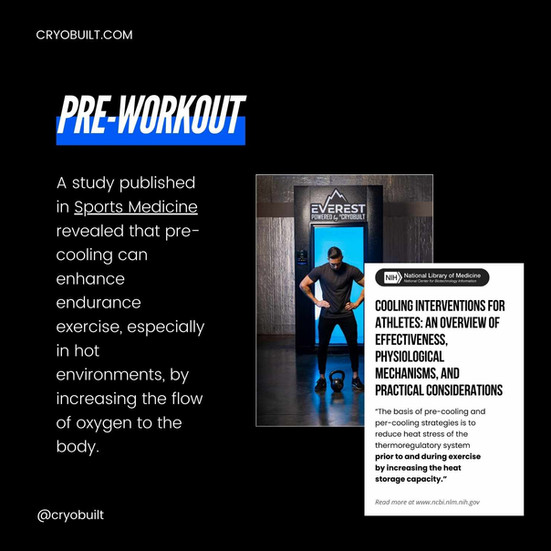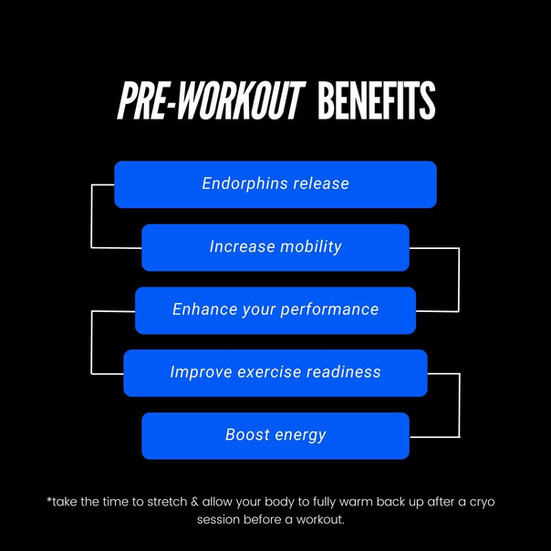In the high-stakes realm of athletic performance, the significance of recovery cannot be emphasized enough. The ongoing debate between cryotherapy and cold plunge reflects a broader discussion on the most effective, efficient, and economical healing practices. Both methods have their advocates and skeptics, making the decision far from straightforward. Cryotherapy and cold plunges may both involve exposure to cold, but they operate at significantly different temperatures. Consequently, they elicit distinct effects on the human body.

Temperature
Cryotherapy, derived from the Greek words "cryo" meaning cold, and "therapeia" meaning cure, is a scientific health treatment that involves extreme cold temperatures. Cold therapy has been around for centuries and can be as simple as an icepack or as complex as cryosurgery. Cryotherapy, at its core, relies on a critical drop in temperature to trigger the body's natural protection mechanisms.
Cryotherapy and cold plunge are two distinct processes with unique effects on the body. During cryotherapy, the body experiences temperatures as low as -165F for 2-3.5 minutes, resulting in a significant drop in body temperature of about 40F.

In contrast, a cold plunge entails longer time durations of 30 seconds to 15 minutes, with temperatures ranging from 35-65F and a body temperature drop of approximately 25F.

Why is this temperature drop so crucial in cryotherapy?
The extreme cold from cryotherapy activates the body’s thermoregulation response in the hypothalamus, which causes a few important things to happen:
When exposed to extreme cold, the body enters survival mode, directing blood flow to the core and infusing it with nutrients and oxygen.
This internal cycle safeguards vital organs, promotes organ performance, and rejuvenates cells. By constricting muscles and tissues, the body defends against hypothermia and death.
The brain signals the body to send toxins to the lymphatic system to be expelled, cells begin a rapid renewal process, and dead cells are eliminated.
The profound impact of temperature drop in cryotherapy cannot be overstated. It initiates a cascade of defense mechanisms that safeguard core temperature.
But how does the temperature drop elicited from cryotherapy differ from that of a cold plunge?
Cryotherapy surpasses cold plunges in terms of frigidity and coverage. As a result, scientific studies have shown that cryotherapy is more effective in lowering skin temperature.

One study found: "Comparatively, while both treatments demonstrated a notable decrease in skin temperature from the initial baseline, whole-body cryotherapy induced a greater reduction compared to cold water immersion."
Cold plunges subject the body to actual, penetrating cold.
At cold plunge temperatures of 35-50F, the body initially tries to warm the blood in its core while maintaining peripheral warmth.
Prolonged exposure to an ice bath can lead to genuine freezing of the muscle tissue. As the cold penetrates the body, the muscles congeal and freeze, starting from the skin's surface and progressing inward. Extended stays in an ice bath can even result in hypothermia, which can be life-threatening.
In contrast, cryotherapy doesn't freeze tissue, but rather tricks our cold sensors into perceiving an intense cold impact when the skin briefly encounters frigid air.
When it comes to cryotherapy, it's important to understand that the skin is not actually frozen. Instead, the sensation of extreme cold is created by exposing the skin to highly chilled air, activating our cold sensors. This doesn't freeze muscle tissue; it simply tricks the body's nervous system into feeling a freezing sensation.

When the nervous system experiences this intense freezing sensation, it swiftly springs into action, exhibiting remarkable reflexes to safeguard the body. While in a cold plunge, where the temperature is much higher, the brain’s first response is to protect the extremities. At -165F, the brain knows there is no way to protect the peripheral parts of the body, and instead turns its attention to safeguarding vital organs. The brain then orders all extremities to constrict muscles and tissues to send blood to the core of the body.
As blood circulates in this internal cycle, it becomes enriched with oxygen and all necessary enzymes and nutrients. This enriched blood creates favorable conditions for internal organ regeneration, expelling toxins from subcutaneous layers, cell renewal process, replacement of damaged cells, and elimination of dead cells from peripheral tissues. This rejuvenation of the body at a cellular level is one of the key benefits of cryotherapy.
Safety
Hypothermia Risk
Cryotherapy cunningly simulates a freezing environment, deceiving the body's sensory responses to cold without causing actual muscle tissue to freeze. In contrast, cold plunges can genuinely freeze muscle tissue, carrying with them the risk of hypothermia if the user stays in for too long.

Cryotherapy does not involve freezing the skin or muscle tissue; instead, it deceives the body's sensory responses to cold by simulating a freezing environment. This triggers a cascade of beneficial bodily responses, without crossing the line into tissue damage, causing actual muscle tissue to freeze. This strategic approach means the treatment is safer and more controlled, offering a higher threshold of cold exposure without the risk of hypothermia or frostbite.

Conversely, the cold plunge immerses the body in water that is cold enough to freeze muscle tissue. This direct contact with freezing temperatures is what gives cold plunges their intense, muscle-stiffening character, and must be undertaken with caution due to the genuine risk of hypothermia with prolonged exposure.
Safety Precautions
Further underlining the safety aspect, cryotherapy practitioners are vigilant about setting controlled time limits and having strict, supervised protocols in place to prevent users from pushing the body too far into a hypothermic state. This tailored approach ensures that individuals receive only the intended benefits of cryotherapy without any adverse reactions.
CryoBuilt has achieved over 10 million cryotherapy sessions without any safety incidents, showcasing the reliability and safety of electric cryotherapy.
Comfort
Cryotherapy, known for its controlled dry air and 3-minute sessions, provides a less jarring conversion from warm to extreme cold and back again. Its lack of humidity reduces the risk of frostbite, and the individual’s core temperature remains warm, ensuring a comfortable and supervised experience without the threat of hypothermia. Many users report cryotherapy to be a much more comfortable and approachable experience in this regard.
On the other hand, cold plunges, especially ice baths, can be a more intense and less predictable method of recovery. The process of plunging into freezing water presents a real shock to the system. While some athletes appreciate the mental strength it builds and its role in contrast therapy, others might find it too uncomfortable or even potentially hazardous.
Timing
Convenience
Cryotherapy is versatile enough to be incorporated into your fitness routine either before hitting the gym to enhance performance through increased alertness and circulation after your workout to accelerate recovery and reduce muscle soreness, or even both for comprehensive benefits. The user is completely dry during a cryotherapy session, making the session quick & convenient.
Cold plunges are usually saved for after your workout to allow for recovery time. As previously mentioned, extremely cold water can cause muscles to freeze and stiffen, so it's important to take some time to relax after immersing yourself. Athletes and fitness enthusiasts must plan for this rest period to ensure muscles properly thaw and regain functionality, preventing the risk of injury stemming from rigid, cold-affected muscles. This inherent delay in recovery positions cold plunge as less conducive for those with a tight schedule or immediate physical engagements post-treatment.
Injury Timing
For certain types of muscular injuries, traditional cold plunges might prove to be more beneficial within the first 24-72 hours.
This is because, during a cold plunge, the muscle tissue is subjected to submersion in ice-cold water, leading to an actual freezing of the muscle tissue. The physical impact of this direct freezing can be better at penetrating deep muscle tissue, providing a more effective recovery treatment for severe muscular injuries.

When it comes to treating serious muscle injuries, acting quickly is essential. Treatment at the onset of injury usually aims to reduce as much blood flow to the injured area as possible, numb pain, and decrease swelling.
Research shows a clear advantage of cold water immersion in these scenarios: "Greater reductions in blood flow and tissue temperature were observed after CWI in comparison with WBC." This study suggests that direct and sustained contact with cold water is more effective at lowering the blood flow and cooling the tissues, which is crucial for initiating the healing process in the early stages of injury recovery.
Moreover, there's anecdotal evidence and real-life examples that suggest cold plunges might be more effective than cryotherapy for severe muscular injuries. Take, for example, a bad hamstring strain - athletes have reported quicker and more focused recovery with cold-water immersion. This is in contrast to whole-body cryotherapy, where the benefits come from the perceived temperature drop without freezing the tissue. In the end, if you're dealing with a serious muscle injury, like pro athletes or folks with deep tissue trauma, cold plunges could be a more powerful and practical solution for targeted recovery compared to cryotherapy's overall effects.
Cost
For Users
Cryotherapy is known for offering a quick, chilling session that can cost an individual an average of $40-$60 per visit. However, wellness centers often package these treatments, offering memberships that can bring the per-session cost down to an affordable $8-15.
On the other hand, a cold plunge provides a similar experience that can cost a user $12-30, which can decrease to $4-9 per session with a membership.
In-home cryotherapy chambers are typically only coveted by celebrities and professional athletes, while cold plunges for personal use are much more accessible. Users who opt for a cold plunge at home might spend as low as $300 for a simple setup or up to $5,000 for a premium, well-insulated model that reaches colder temperatures than an ice barrel.
For Wellness Centers
Upfront costs can be steep for wellness centers investing in cryotherapy chambers. The initial setup for a nitrogen-based cryo chamber starts at $50,000, with the more popular electric models starting at $90,000 and often climbing much higher. Though electric chambers may cost more upfront, operating on liquid nitrogen significantly increases operational expenses compared to the modest rise in electricity bills for an electric chamber, typically less than $20 per day.
On the other hand, a basic cold plunge setup requires a much smaller investment of $1,000-$15,000, offering a more cost-effective option for wellness centers that value ease of management. At many wellness centers, cold plunges are frequently complemented with far infrared sauna sessions as a form of contrast therapy, known for enhancing circulation and recovery. On average, patrons can expect to pay between $60 to $125 per session for the synergistic benefits of this temperature variation therapy.
While cryotherapy offers varied membership deals for users and the potential for a high return on investment for wellness centers, cold plunges have a lower entry cost and can be more cost-efficient for home users. Ultimately, the choice between cryotherapy and a cold plunge comes down to the user's budget and convenience, as well as the wellness center's long-term financial and operational considerations.

Overall
Cryotherapy and cold plunges may both involve exposure to cold, but they operate at significantly different temperatures. Consequently, they elicit distinct effects on the human body.
In terms of temperature reduction, which is the fundamental attribute of cold therapy, whole-body cryotherapy surpasses cold plunges by effectively lowering body temperature to 40F compared to the more moderate 25F achieved by cold plunges. This temperature drop elicits a more profound physiological response in the body, resulting in greater potential benefits.
In regards to safety, cryotherapy takes the win. Unlike cold plunges, whole-body cryotherapy employs a method of temperature reduction that doesn't involve the actual freezing of tissues, thereby ensuring a safer experience.
Many users find cryotherapy to be more comfortable and approachable. Athletes are also able to use cryotherapy before and after a workout, while cold plunges can only be done after. Many people find cold plunge a better fit for contrast therapy. While we are firm believers in the safety and effectiveness of cryotherapy, it's important to note that for certain types of severe muscular injuries, traditional cold plunges may prove to be more beneficial.
Cold plunges are a more budget-friendly form of cold therapy, though cryotherapy memberships & cryo chamber financing can help to lower the cost of owning or utilizing WBC.
So- which are you opting for?
References
Abd-Elbasset Abaidia, Julien Lamblin, Barthelemy Delecroix, Cédric Leduc, Alan Mccall, et al.. Recovery From Exercise-Induced Muscle Damage: Cold-Water Immersion Versus Whole-body Cryotherapy. International Journal of Sports Physiology and Performance, 2017, 12 (3), pp.402-409. ff10.1123/ijspp.2016-0186ff. ffhal-02524887f
Costello JT, Culligan K, Selfe J, Donnelly AE. Muscle, skin and core temperature after -110°c cold air and 8°c water treatment. PLoS One. 2012;7(11):e48190. doi: 10.1371/journal.pone.0048190. Epub 2012 Nov 6. PMID: 23139763; PMCID: PMC3491015.
Mawhinney C, Low DA, Jones H, Green DJ, Costello JT, Gregson W. Cold Water Mediates Greater Reductions in Limb Blood Flow than Whole Body Cryotherapy. Med Sci Sports Exerc. 2017 Jun;49(6):1252-1260. doi: 10.1249/MSS.0000000000001223. PMID: 28141620.
Srámek P, Simecková M, Janský L, Savlíková J, Vybíral S. Human physiological responses to immersion into water of different temperatures. Eur J Appl Physiol. 2000 Mar;81(5):436-42. doi: 10.1007/s004210050065. PMID: 10751106.
Vieira Ramos G, Pinheiro CM, Messa SP, Delfino GB, Marqueti Rde C, Salvini Tde F, Durigan JL. Cryotherapy Reduces Inflammatory Response Without Altering Muscle Regeneration Process and Extracellular Matrix Remodeling of Rat Muscle. Sci Rep. 2016 Jan 4;6:18525. doi: 10.1038/srep18525. PMID: 26725948; PMCID: PMC4698758.





















Comments